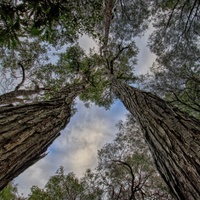Common name: Jarrah
Other common names: Djarraly
Description
Eucalyptus marginata, commonly known as Jarrah, is a large evergreen tree up to 40 meters (130 feet) tall. It is native to the southwestern parts of Western Australia and known for its dense, hard timber, which ranges in colour from red to deep brown. Jarrah has rough, fibrous bark that covers its trunk and branches, which peels away in long strips. The leaves are lance-shaped, dark green, and leathery, arranged alternately on the branches. It produces white to cream-coloured flowers from spring to summer, followed by small, woody fruits.
Use
Jarrah timber is highly prized for its exceptional durability, hardness, and natural resistance to decay and termites, making it ideal for a range of applications, both indoors and outdoors. It is used extensively in heavy construction, including bridges, railway sleepers, and marine structures, where its strength and resistance to marine borers are particularly valued. The rich, dark red timber is also a favourite for fine furniture, cabinetry, and flooring. Its resilience in outdoor settings, such as fencing, decking, and coastal engineering projects, further showcases its versatility.
In addition to its timber, Jarrah plays a significant role in apiculture. The tree's nectar-rich flowers support honey production in Western Australia, yielding amber-coloured honey with a distinctive, rich flavour.
While the tree produces a small quantity of essential oil, this remains a lesser-known by-product than its prominence in timber and beekeeping industries.
Climate
Jarrah thrives in a Mediterranean climate characterized by hot, dry summers and mild, wet winters. Once established, it prefers areas with annual rainfall between 600 and 1300 mm and can withstand prolonged dry periods.
Jarrah is common in the southwestern corner of Western Australia, particularly in Jarrah forests stretching from Perth to Albany. It also grows well in areas like the Darling Range, where it is a dominant species. Jarrah may also thrive in regions outside of its native range with similar climates, such as parts of southern Europe and California.
Growing
Jarrah is typically grown from seed, which readily germinate when exposed to smoke or heat treatment, mimicking conditions of natural wildfires in its native environment. It prefers full sun and well-drained, sandy soils but can also adapt to loam and gravel soils. Once established, it is highly drought-tolerant and requires little maintenance. The tree's extensive root system makes it resistant to windthrow but can cause challenges in urban environments if planted near structures or underground utilities.
Problem features
Jarrah is known for its vigorous growth, which can sometimes lead to invasiveness when introduced outside its native habitat. It is also susceptible to the soil-borne pathogen Phytophthora cinnamomi, which causes root rot and dieback, significantly affecting Jarrah forests in Western Australia. Additionally, its large size and extensive root system can pose challenges in urban landscaping, including damage to nearby buildings and infrastructure.
Where it grows
References
Books
-
Boland, D. & Brooker, I. & McDonald, M. W. 2006, Forest trees of Australia, 5th ed., CSIRO Publishing (Ensis), Melbourne
-
Brown, W. H. (William Henry). 1978 -1979. Timbers of the world. Vols. 1-9. Timber Research and Development Association (TRADA), High Wycombe
-
Crossman, M. & Simm, J. & Great Britain. Dept. of Trade and Industry & HR Wallingford (Firm) & Environment Agency (Great Britain) 2004, Manual on the use of timber in coastal and river engineering, Thomas Telford, London
-
Howard, A. L. 1948, A manual of the timbers of the world: their characteristics and uses, 3d ed., with an index of vernacular names, Macmillian, London
-
Porter, T. 2012, Wood : identification & use, Compact edition, Guild of Master Craftsman Publications, Lewes, East Sussex
-
Randall, R. P. 2002, A global compendium of weeds, R.G. and F.J. Richardson Press, Melbourne
-
Randall, R. P. 2007, The introduced flora of Australia and its weed status, Cooperative Research Centre for Australian Weed Management, Glen Osmond, South Australia
-
Scheffer, T. C & Morrell, J. J. 1998, Natural durability of wood : a worldwide checklist of species, Forest Research Laboratory, Oregon State University, Corvallis, Oregon
Articles, Journals, Reports and Working Papers
-
Gardner, C. A. (1952) "Trees of W.A. Jarrah and Karri," Journal of the Department of Agriculture, Western Australia, Series 3: Vol. 1: No. 1, Article 14.
-
Smith, F G. (1969), Honey plants in Western Australia. Department of Primary Industries and Regional Development, Western Australia, Perth. Bulletin 3618.


